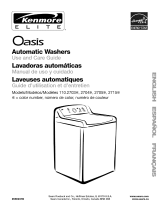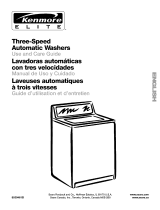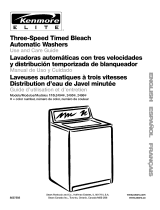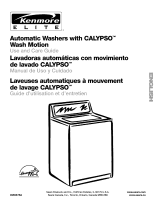Page is loading ...

Owner's Manual and
Installation Instructions
®
Two-Speed
Speed Control
AUTOMATIC WASHERS
IMPORTANT:
Read and follow all safety
and operating instructions
before first use of this product.
Your washer may look different
from the washer shown.
Sears, Roebuck and Co., Hoffman Estates, IL 60179 U.S.A.
PART NO. 3950145 Rev. A PRINTED IN U.S.A.
_
g
g
g
g
H
l
/

BEFORE USING YOUR NEW WASHER
2
SEARS AUTOMATIC WASHER WARRANTY
3
IMPORTANT SAFETY INSTRUCTIONS 4
INSTALLATION INSTRUCTIONS
5
OPERATING YOUR WASHER
20
LAUNDRY TIPS
30
CARING FOR YOUR WASHER
32
TROUBLESHOOTING
33
SEARS MAINTENANCE AGREEMENT
37
Please read this manual. It will help
you install and operate your new
Kenmore washer in the safest and
most economical way.
For more information about the care
and operation of Kenmore appliances
call your nearest Sears store. You will
need the complete model and serial
numbers when requesting information.
Your washer's model and serial numbers
are located on the Model and Serial
Number Plate.
Use the space below to record the model
number and serial number of your new
Kenmore Washer.
Model No.
Serial No.
Date of Purchase
Model and Serial
NumberPlate
Keep this book and your Sears
Salescheck (receipt) in a safe place
for future reference.
2

FULL 1-YEAR WARRANTY
ON MECHANICAL AND
ELECTRICAL PARTS
For one year from the date of purchase,
when the washer is installed and operated
in accordance with the instructions in
the Owner's Manual, Sears will repair or
replace any mechanical or electrical parts
in this washer, if defective in material or
workmanship.
LIMITED 5-YEAR WARRANTY
ON GEARCASE PARTS
After one year and until five years from
the date of purchase, Sears will furnish
replacement parts for any defective gear-
case parts. You will be charged for labor.
LIMITED 10-YEAR WARRANTY
ON PLASTIC TUB
After one year and until ten years from
date of purchase, Sears will furnish a
replacement plastic tub for any plastic
tub which is defective in material or work-
manship. You will be charged for labor.
If the washer is subjected to other than
private family use, the above warranty
coverage is effective for only 90 days.
WARRANTY SERVICE IS AVAILABLE
BY CONTACTING THE NEAREST
SEARS SERVICE CENTER IN THE
UNITED STATES.
This warranty applies only while this
product is in use in the United States.
This warranty gives you specific legal
rights, and you may also have other
rights which vary from state to state.
Sears, Roebuck and Co., Dept. 817WA,
Hoffman Estates, IL 60179.
Your safety and the safety of others is very important.
We have provided many important safety messages in this manual
and on your appliance. Always read and obey all safety messages.
This is the safety alert symbol. This symbol alerts
you to hazards that can kill or hurt you and others.
All safety messages will be preceded by the safety
alert symbol and the word "DANGER" or "WARNING:'
These words mean:
You will be killed or seriously
injured if you don't follow
instructions.
You can be killed or seriously
injured if you don't follow
instructions.
All safety messages will identify the hazard, tell you how to reduce the
chance of injury, and tell you what can happen if the instructions are
not followed.

YOUR SAFETY IS IMPORTANTTO US
WARNING: To reduce the risk of fire,
electric shock, or injury to persons
when using your washer, follow basic
precautions, including the following:
• Read all instructions before using
the washer.
• Do not wash articles that have been
previously cleaned in, washed in, soaked
in, or spotted with gasoline, dry-cleaning
solvents, other flammable or explosive
substances as they give off vapors that
could ignite or explode.
• Do not add gasoline, dry-cleaning
solvents, or other flammable or explosive
substances to the wash water. These
substances give off vapors that could
ignite or explode.
• Under certain conditions, hydrogen gas
may be produced in a hot water system
that has not been used for 2 weeks or
more. HYDROGEN GAS IS EXPLOSIVE.
If the hot water system has not been
used for such a period, before using a
washing machine, turn on all hot water
faucets and let the water flow from each
for several minutes. This will release any
accumulated hydrogen gas. As the gas is
flammable, do not smoke or use an open
flame during this time.
• Do not allow children to play on or in
the washer. Close supervision of children
is necessary when the washer is used
near children.
• Before the washer is removed from
service or discarded, remove the lid.
• Do not reach into the washer if the tub
or agitator is moving.
• Do not install or store this washer where
it will be exposed to the weather.
• Do not tamper with controls.
• Do not repair or replace any part of the
washer or attempt any servicing unless
specifically recommended in the Owner's
Manual or in published user-repair
instructions that you understand and
have the skills to carry out.
SAVE THESE INSTRUCTIONS
IMPORTANT: Observe all governing codes and ordinances.
4

INSTALLATION OVERVIEW
For a complete list of tools and parts
needed, see pages 6-8.
A. SELECT LOCATION
FOR YOUR WASHER (pgs. 10-12)
Recessed Area/
Closet Installation Instructions (p. 10)
Standpipe Drain System (p. 12)
LaundryTub Drain System (p, 11)
Floor Drain System (p. 12)
39"
1
5

B. REMOVE SHIPPING STRAP (p. 13)
O
Tools Needed:
Scissors Flashlight (optional
depending on installation)
C. CONNECT DRAIN HOSE (pgs. 14-15)
Tools Needed: Parts Needed:
Pliers that open
to 19/_8inches
Flashlight (optional
depending on installation)
1 yellow, single-wire
hose clamp (top of
drain hose)
1 silver, double-
wire hose clamp
(bottom of drain
hose)

D. CONNECT INLET HOSES TO WASHER (pgs. 15-16)
Tools Needed: Parts Needed:
Pliers that open
to lg/_s inches
Flashlight (optional
depending on installation)
hoses
4 flat water inlet hose washers
E. CONNECT INLET HOSESTO WATER FAUCETS (p. 16)
Tools Needed: Parts Needed:
Pliers that open to 19/_6inches
depending on
installation)
Flashlight (optional
depending on installation)
2 water inlet hoses

F. SECURE DRAIN HOSE (p. 17)
Tools Needed: Parts Needed:
Flashlight (optional
depending on installation)
Shipping strap with fastener
G. LEVEL WASHER (p. 18)
h
Tools Needed: Parts Needed:
9/_6-1nch
open-end wrench
Flashlight (optional
Wood block
depending on installation)
2 front leveling legs with nuts

Selecting the proper location for your
washer will improve its performance
and minimize concerns like washer
walk or noise.
ELECTRICAL REQUIREMENTS
120-Volt, 60-Hz., AC-only, 15- or
20-ampere fused electrical supply is
required. (Time-delay fuse or circuit
breaker is recommended.) Connect to
individual branch circuit.
Electrical Shock Hazard
Plug into a grounded 3-prong
outlet.
Do not remove ground prong.
Do not use an adapter.
Do not use an extension cord.
Failure to follow these instructions
can result in death, fire, or
electrical shock.
GROUNDING INSTRUCTIONS
m
WARNING: Improper connection of
the equipment grounding conductor can
B
result in a risk of electric shock. Check
with a qualified electrician or serviceman
if you are in doubt as to whether the
appliance is properly grounded. Do not
modify the plug provided with the appli-
ance - if it will not fit the outlet, have
a proper outlet installed by a qualified
electrician.
For your personal safety, this washer
must be grounded. In the event of
malfunction or breakdown, grounding
will reduce the risk of electric shock
by providing a path of least resistance
for electric current.
This washer is equipped with a power
supply cord having a 3-prong grounding
plug. To minimize possible shock hazard,
you must plug the power supply cord
into a mating 3-prong grounding-type
wall receptacle, grounded in accordance
with National Electrical Code, ANSI/NFPA
70-latest edition and all local codes and
ordinances.
3-Prong
Grounding-Type
Wall Receptacle
3-Prong
Grounding Plug
_o ing
ng
Supply
rd
©
9

A. SELECT LOCATION
FOR YOUR WASHER -
RECESSED AREA/
CLOSET INSTALLATION INSTRUCTIONS
This washer may be installed in a recessed area or closet.
FrontView
(Door NotShown)
4('_'1"
SideView FrontView
(DoorShown) (DoorWithVent)
*Additionalclearanceforwall,doorandfloormoldingsmayherequired.
Toreducetransferofwashersounds,a clearanceolI inchonthesidesofthewasherisrecommended.
**Washerwidthcanbe24"or27"dependingonmodelselected.
• The installation spacing is in inches
and is the minimum allowable.
• Allow additional space ifother appli-
ances are to be installed in the area.
• If closet door is installed, the mini-
mum air openings in top and bottom
are required. Louvered doors with
equivalent air openings in top and
bottom are acceptable.
10

LAUNDRY TUB DRAIN SYSTEM
Check location where washer will be
installed. This washer can be installed
using one of three systems:
• Laundry tub drain system (below)
• Standpipe drain system (p. 12)
• Floor drain system (p. 12)
Grounded receptacle: Must
be within 4 feet ofwhere the
power cord is attached tOthe
back of the washer.
Do not store or operate washer at or
below 32°F (some water may remain in
washer). See page 32 for Winterizing
Information.
Proper installation is your responsibility.
Make sure you have everything necessary
for correct installation including the
following points:
Hot and cold water faucets:
Must providewater pressure
between 5-100 psi and be
within 4 feet ofthe hot and
cold water fill valves attached
to the back ofthe washer.
Laundry tub drain system:
Needs a minimum 20-gallon
laundry tub.
Support: Floor must be sturdy
enough to support a total weight
of 315 pounds (including washer,
water, and load weight).
Level floor: Maximum
allowable slope under entire
washer - 1 inch.
Top of tub must be at
least 39 inches above
floor and no higher
than 96 inches from
bottom of washer.
11

ALTERNATE LOCATIONS -
STANDPIPE AND FLOOR DRAIN SYSTEMS
Standpipe drain system: Needs a two-inch
minimum diameter standpipe with minimum
carry-away capacity of 17 gallons per minute.
Top of standpipe must be at least 39 inches
above floor and no higher than 96 inches
from bottom of washer.
Siphon break: Must be purchased
separately. See chart below.
Floor drain system: Requires a siphon
break, see chart below. A minimum carry-
away capacity of 17 gallons per minute
is required.
If you have: You will need to buy:
Laundry tub or standpipe Sump pump system
taller than 96 inches (if not already available)
1-inch diameter standpipe 2-inch diameter to 1-inch diameter
standpipe adapter, Part No. 3363920
Overhead sewer Standard 20 gallon, 39-inch tall drain
tub or utility sink and sump pump
(available from local plumbing suppliers)
Floor drain Siphon break, Part No. 285320;
additional drain hose, Part No. 3357090
and Connector Kit, Part No. 285442
Parts listed are available from your local Sears store or Sears Service Center.
Call 1-800-366-PART (1-800-366-7278).
12

B. REMOVE SHIPPING STRAP
Removing the shipping strap is
necessary for smooth operation.
If the shipping strap is not
removed, the washer will make
excessive noise.
To prevent floor damage, set washer onto
cardboard before moving across floor.
Move washer close to its final location.
STEP 1. Read, then remove the label
over the electrical plug and shipping strap.
STEP 2. Pull the yellow shipping strap
completely out of the washer. There
should be three cotter pins on the end
of the shipping strap when it is pulled
out of the washer. The electrical plug is
attached to this shipping strap.
STEP 3. Pull firmly to remove the
other end of the shipping strap pinned
to the back of washer. This will
release the rear self-leveling legs.
.in PULL
Electricalplug
o
STEP 4. Cut the shipping strap about
16 inches from plug end. Look for the
words "CUT HERE" Discard end with
three cotter pins. Slide remainder of
shipping strap free from the electrical
plug. You will use this to secure the
drain hose.
Shippingstrap
o
PULL
Pin
13

C. CONNECTDRAINHOSE
Proper connection of the drain hose
will protect your floors from damage
due to water leakage.
STEP 1. To prevent the drain hose from
coming off or leaking, it must be installed
per the following instructions:
IMPORTANT: To ensure proper installa-
tion, this procedure must be followed
exactly.
a. Wet the inside of the straight end of
the drain hose with tap water. DO
NOT USE ANY OTHER LUBRICANT.
b. Squeeze ears of silver, double-wire
clamp with pliers to open, Place clamp
over the straight end of the drain hose
1/4inch from the end.
AND
PUSH
1/4"
d. Place clamp over area marked
"CLAMP." Release clamp.
c. Open clamp. Twist hose back and
forth while pushing down onto drain
connector at the bottom of the washer.
Continue until hose contacts the
ribbed stop on the cabinet.
1/4"
If you have: You will need to buy:
Drain hose that is too short Drain hose, Part No. 388423 and
hose kit, Part No. 285442
Drain hose that is too long Hose kit, Part No. 285442
A problem with lint clogging your drain Drain protector, Part No. 367031
Parts listed are available from your local Sears store or Sears Service Center.
Call 1-800-366-PART (1-800-366-7278).
14

For standpipe or laundry tub drain
systems:
STEP 2. Open yellow, single-wire clamp
with pliers and slide over hooked end
of drain hose to secure the rubber and
corrugated sections together.
HookedEnd
STEP 3. Put hooked end of drain hose
into laundry tub or standpipe. Check
for proper length of drain hose. Rotate
hook to eliminate kinks.
To prevent drain water from going back
into the washer:
• Do not straighten hooked end of drain
hose and force excess drain hose into
standpipe.
• Do not lay excess drain hose in bottom
of laundry tub.
D. CONNECT INLET HOSES
TO WASHER
Proper connection of your inlet hoses
will allow hot and cold water to enter
your washer properly. It also helps
prevent water damage due to leaks.
Slip and Fall Hazard
Use new water inlet hoses.
Failure to do so can result in head
injury or broken bones.
NOTE: Replace inlet hoses after five
years of use to reduce the risk of hose
failure. Periodically inspect and replace
inlet hoses if bulges, kinks, cuts, wear,
or leaks are found. When replacing
your inlet hoses, mark the date of
replacement on the label with a
permanent marker.
STEP 1. Insert one new, flat washer
(from the parts bag) into each end of
the inlet hoses, Check that washers
are firmly seated in couplings.
0
COUPLING WASHER
15

STEP 2, Attach the hose with the red
coupling to the hot water (bottom) inlet
valve. Attaching the red coupling first
makes it easier to tighten connection
with pliers. Screw on coupling by hand.
Make an additional two-thirds turn with
pliers to tighten coupling. DO NOT
OVERTIGHTEN; this could damage
the valves.
Cold Water
Inlet Valve
E. CONNECTINLETHOSES
TOWATER FAUCETS
STEP 1, Make sure washer basket is
empty. Run water through both faucets
into a bucket or laundry tub to get rid of
particles in the water lines that might
clog hoses. Determine which faucet is
hot and which is cold. Mark the hot water
faucet.
Hot
Water
Inlet
Valve
STEP 3. Attach the hose with the blue
coupling to the cold water (top) inlet
valve. Screw on coupling by hand. Make
an additional two-thirds turn with pliers
to tighten coupling. DO NOT OVER-
TIGHTEN; this could damage valves.
STEP 2. Attach the hose with the red
coupling to the hot water faucet. Screw
on coupling by hand. Make an additional
two-thirds turn with pliers to tighten cou-
pling. DO NOT OVERTIGHTEN; this
could damage the coupling.
STEP 3. Attach the hose with the blue
coupling to the cold water faucet.
Screw on coupling to faucet by hand.
Make an additional two-thirds turn with
pliers to tighten coupling. DO NOT
OVERTIGHTEN; this could damage
the coupling.
STEP 4. Turn on water faucets and
check for leaks. A small amount of
water may enter the washer. You will
drain this later.
If you have: You will need to buy:
Water faucets beyond the 2 longer water fill hoses: 6 ft. hoses,
reach of water fill hoses Part No. 76314 or 10 ft. hoses,
Part No. 350008
Parts listed are available from your local Sears store or Sears Service Center.
Call 1-800-366-PART (1-800-366-7278).
16

F. SECURE DRAIN HOSE
Securing the drain hose properly will
protect your floors from damage due
to water leakage,
STEP 1. Move washer to its final
location.
J
STEP 2. Locate the remaining piece
of shipping strap (not the end with the
three cotter pins) from STEP 4 of
"REMOVE SHIPPING STRAP." Use
it to wrap the drain hose together with
the laundry tub or standpipe. Push
fastener into the nearest hole in the
shipping strap.
m
If the water faucets and drain standpipe
are recessed, put hooked end of drain
m
hose in standpipe. Tightly wrap the
shipping strap around the drain hose
and water inlet hoses (not the handles
or stems). Push fastener into the
nearest hole in the shipping strap.
I
Fastener
17

G. LEVELWASHER
Leveling your washer properly pre-
vents excessive noise and vibration.
To install front legs:
STEP 1. Prop front of washer up (about
4 inches). Use a wood block or another
object that will support the weight of the
washer, if washer was placed against
a wall, move the washer out slightly
before tipping it up.
STEP 2. With one of the legs in hand,
screw lock nut onto leg 3/8inch from top
of leg base. This is the recommended
initial setting.
STEP 3. Screw leg into washer base by
hand until nut reaches washer base.
Repeat for other leg.
STEP 4. Tilt washer backward until
front of washer is off the wood block.
Remove wood block. Gently lower
washer to floor.
STEP 5. Move washer to its final
location.
STEP 6. Tilt washer forward until rear
of washer is at least 3 inches off floor.
You may hear the self-adjusting rear
legs click into place. Lower washer to
floor. Check levelness of the washer
by placing a level on top of the washer,
first side-to-side; then front-to-back.
hi v
STEP 7. If washer is not level, prop
up the front of the washer and adjust
the legs up or down as necessary. Lower
washer and reset self-adjusting rear legs
(as in Step 6). Repeat Step 7 until
the washer is level.
STEP 8. When washer is in its final
location and level, use a 9/1s-inch open-
end wrench to turn nuts on front legs
tightly against washer cabinet. If nuts
are not tight against washer cabinet,
the washer may vibrate.
18

REVIEW INSTALLATION
Take a few minutes to complete
this checklist. It will help assure you
that you have a proper installation
and increase your satisfaction with
your Kenmore washer.
[]
[]
Check electrical requirements.
Be sure you have correct electrical
supply and recommended grounding
method.
Check that you have:
• All the tools you started with.
• Removed all packaging materials.
• Removed shipping strap with
three cotter pins.
• Installed all parts listed on
pages 6-8.
[] Check that:
• The washer is level.
• The nuts on the front legs are tight.
[] Check that the water faucets are
turned on.
FINAL STEPS
[] Plug power supply cord into
grounded outlet.
[] Remove the blue protective film on
the console and any tape remaining
on washer.
[] Take a few minutes and read the
Operating Instructions (pages 20-29)
to fully understand your new washer.
Then, start the washer and allow it
to complete the ULTRA CLEAN or
NORMAL Cycle.
19

To get the maximum cleaning and
fabric care from your washer, please
read and follow these instructions.
NOTE: The drawings in this section
show the basic features of all models
covered by this manual. Refer to the
supplied "Feature Sheet" for your
washer's particular features.
Explosion Hazard
Never place items in the washer
that are dampened with gasoline
or other flammable fluids.
No washer can completely
remove oil.
Do not dry anything that has ever
had any type of oil on it (including
cooking oils).
Failure to follow these instructions
can result in death, explosion,
or fire.
STARTING WASHER
STEP 1. Add measured detergent
directly into washer basket. Then place
a load of sorted clothes in the washer.
STEP 2. (OPTIONAL STEP) If desired,
add measured liquid chlorine bleach to
the liquid bleach dispenser (see page 27).
STEP 3. (OPTIONAL STEP) If desired,
add measured liquid fabric softener to
the fabric softener dispenser (see page 28
STEP 4. Close washer lid.
STEP 5, Set WATER LEVEL Control O
based on the size of your wash load (see
page 21 ).
STEP 6. Set the WATER TEMPERATURE
Control O (see page 22).
STEP 7. Set RINSE OPTIONS Control
(if available) _ (see page 25).
STEP 8, Set SPEEDS_Control
according to the type of fabric in the
load (see page 23).
STEP 9. Push the Cycle Selector
Control (Timer) Knob _) in and turn
to the right to desired setting (see page 24
STEP 10. Pull the Cycle Selector Control
(Timer) Knob out. The dial will rotate as th
cycle progresses. The knob will not rotate.
STOPPING/RESTARTING WASHER
• To stop the washer at any time, push
the Cycle Selector Control (Timer)
Knob in.
• Pull the knob out to restart,
2O
/




